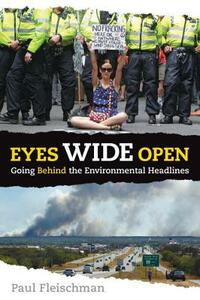Take a photo of a barcode or cover
I read this book as part of a school project in my AP Chemistry class. Initially, I expected it to be another boring book about the need to save the environment, which everyone knows. Of course we realize that global warming and CO2 levels are rising alarmingly, but this novel alerted me to a part of the industry I had never known about. Fleischman effectively describes the numerous factors in our society contributing to climate change, especially the existence of vested interests. Yet Fleischman doesn't stop there. He explains factors such as normalcy bias, which isn't a common term for all of us who aren't taking AP Psychology, and how they play a key role in our decisions we make every day. Why aren't we doing more to stop climate change? Because we don't see the changes it's impacting on our lives – nothing's changed for us. Unfortunately, it's not something you can see and avoid, which has led to a positive feedback loop in which we exacerbate the problem. Additionally, he relates vested interests to the fossil fuel industry, who has donated money to all the right places and created doubt about climate change in hopes of extending their bottom line. Yet Fleischman does not merely create an interesting novel through his subject matter, but through the way in which he writes the novel. It's written with everyday language that a teenager or adult could easily comprehend. He doesn't use specific jargon or slang that only scientists would understand, but uses common words to appeal to a larger audience in hopes of getting his idea across. And finally, Fleischman introduces the idea of reading critically. As a high school student, I'm used to hearing those words. But Flesichman helps elucidate the idea even more clearly by providing a context in which to do so. When reading about climate change, it is important to think about the source of the news you're reading. To think about the vested interests and biases that may influence the writing. And to pick and choose news articles with together can combine to create the full story, rather than reading one and getting merely a piece. Overall, this book was very enjoyable as it made me aware of many influences politically on the persistence of climate change.
What I appreciated most about this book was the wealth of resources it draws from and points readers toward. So many of the topics discussed have a tag in the margin saying "learn more at this website" or "search for similar headlines in your local papers" or "this documentary will give a specific view on the issue". It gives a good view of the basic reasons why climate change is concerning and why it can be hard for people to want to tackle the issue, for political, pecuniary, and psychological reasons. I love the breadth of the topic covered. I wish it did more to encourage or suggest easy ways to get involved and make changes, but the argument that it does make is a really important step to helping people be educated on the issue and care more about how they do contribute (both to problems and solutions!).
The book is geared toward teens, and it would easily be appropriate reading for any middle school or high school class. It's a simple read that's a great introduction to some of the big players and systems involved in our current environmental issues.
I would recommend it to everyone who's invested in living on this planet.
The book is geared toward teens, and it would easily be appropriate reading for any middle school or high school class. It's a simple read that's a great introduction to some of the big players and systems involved in our current environmental issues.
I would recommend it to everyone who's invested in living on this planet.
I really have to give credit to this graphic designer, what a wonderful job. I really like how this book is laid out w/ the various graphics, sidebar, pics, quotes & other tidbits that make it unique. Kudos to the author as well for a super great read. There is so much information about what makes a headline what it is & how it gets to be mainstream. not only is there a timeline of historic events throughout the book but also the people who were there trying to take a stand to make things right. This book addresses many different issues & vantage points about the climate crisis & the way they do it just makes sense for everyone to understand what is happening. Whether population booms, capitalism, oil expansion, etc. so much is being brought up that one may not even be aware of. Knowing what countries have been doing to make things worse or realizing what cap & trade is about or how wars exacerbate the problems for millions of people, the climate deniers just can't open their eyes or brains. Then there's the list of resources in the back that will also give you a slew of info to check out so one can learn even more. I can't help but recommend this book to everyone.
**********
Most informative. A wonderful resource. A copy of this book should be in every home.
Most informative. A wonderful resource. A copy of this book should be in every home.
I was required to read this for a college course, and I had an open mind about it, despite it being an assignment. I enjoyed the layout of the book; the endless visuals were well done and made it significantly more appealing to read than if it were just black text on white pages. Fleischman also touched upon a lot of information about the environment worldwide that could be useful for people who are particularly interested in that field. However, it is personally not my cup of tea, hence my rating. But I still learned a lot while reading it!
informative
medium-paced
This is the perfect YA nonfiction book on environmentalism and environmental justice. Breaking everything down bit by bit, Fleischman introduces topics such as critical information literacy, environmental racism, and carbon footprints. By using his hometown as a starting point, he offers various ways in which to view how our society has changed both locally and internationally. Why have there been international conferences in both Paris and Kyoto? What's the United States' involvement in these? What are we doing? What are they doing?
He offers a lot of questions and answers them, too. With dynamic page layouts and resources, this book offers a lot both in terms of information and design, but in its own personal ethics, too (it was made on recycled paper)!
With the use of his own writing, newspaper headlines, resources, photographs, and a glossary, he successfully makes his purpose clear: to be able to assess headlines we must first be able to assess our own communities as well as ourselves, and be able to perform appropriate research.
Definitely a must-read in regards to YA nonfiction!
Review cross-listed here!
He offers a lot of questions and answers them, too. With dynamic page layouts and resources, this book offers a lot both in terms of information and design, but in its own personal ethics, too (it was made on recycled paper)!
With the use of his own writing, newspaper headlines, resources, photographs, and a glossary, he successfully makes his purpose clear: to be able to assess headlines we must first be able to assess our own communities as well as ourselves, and be able to perform appropriate research.
Definitely a must-read in regards to YA nonfiction!
Review cross-listed here!
Possibly(I think, definitely) the best book I've read this year. This is a terrific overview of current environmental issues, in easy and interesting language. The presentation is not overwhelming, with just enough design space around the text. Captions and bullet points in the margin offer online and text connections to great resources and I spent my whole day moving back and forth between the book and various videos and websites.
The focus of the book is to be a conscious and wary consumer of information. Fleischman would make a great librarian!
I can't rave enough.
The focus of the book is to be a conscious and wary consumer of information. Fleischman would make a great librarian!
I can't rave enough.
I totally believe in global warming and want us to change our ways, but this book was tough to take. First of all it is a lot of information and would be better as a reference than a read straight through. It is interesting and important, but a lot to handle all at once. Also, the author's opinion on the subject in VERY clear. If I were anti-global warming I would have felt like this was shoving it down my throat. Lastly, I think the tone is often condescending. In an attempt to get kids to enjoy the read, the author ends up talking down to them. My favorite example, "Everyone's happy at Halloween, with candy flowing from every door; plenty brings peace. Scarcity brings strife." Just dumb.




